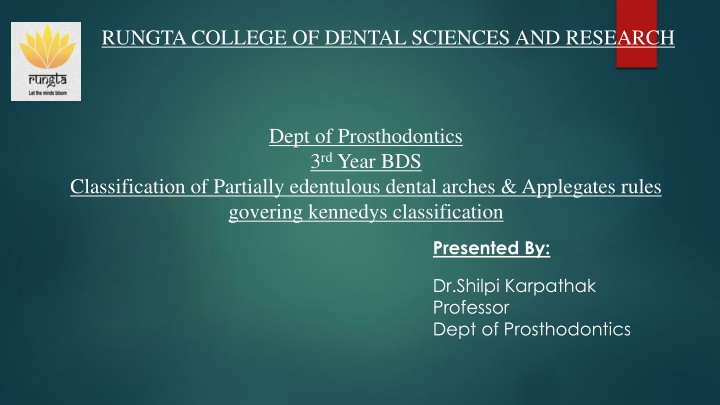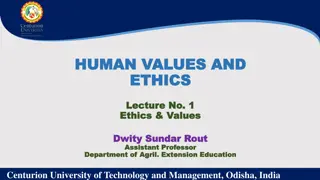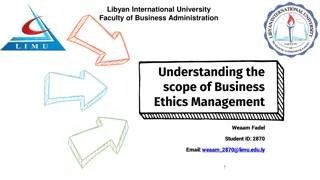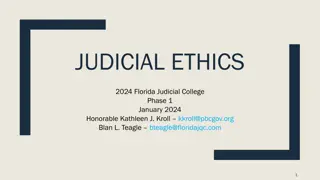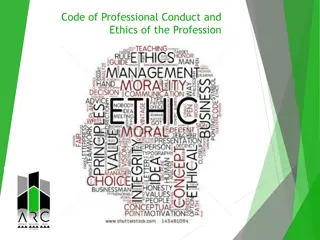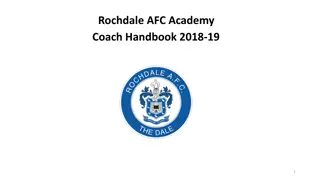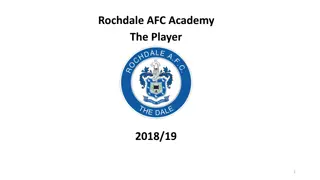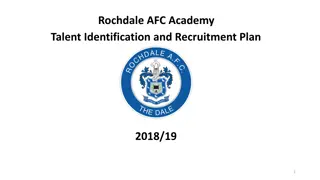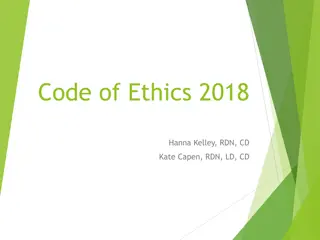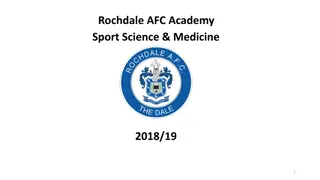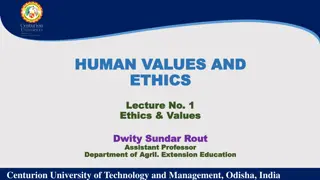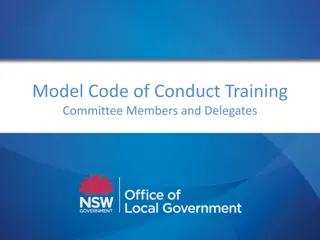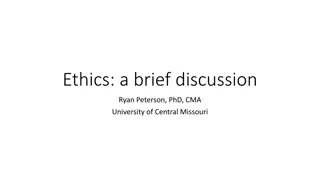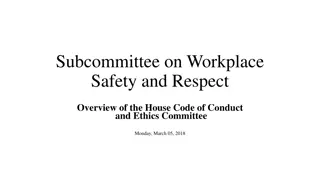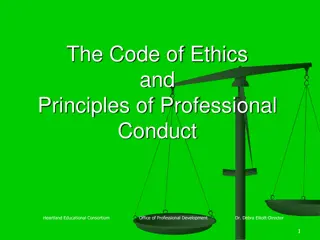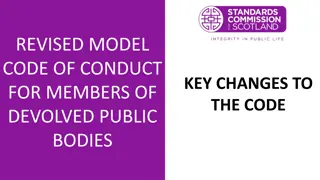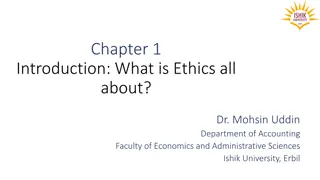Greystones Utd AFC Code of Ethics Programme & Conduct Guidelines
Greystones Utd AFC has established a comprehensive programme outlining the code of conduct and good practices for parents/guardians of players. Emphasizing support, encouragement, and fair play, the guidelines stress the importance of parental involvement in fostering a positive environment for young athletes. By setting realistic targets, promoting healthy habits, and collaborating with coaches, parents/guardians play a pivotal role in shaping the attitudes and behaviors of children in football. The programme emphasizes respect, sportsmanship, and the overall well-being of players, discouraging negative behaviors and undue pressure.
Download Presentation

Please find below an Image/Link to download the presentation.
The content on the website is provided AS IS for your information and personal use only. It may not be sold, licensed, or shared on other websites without obtaining consent from the author.If you encounter any issues during the download, it is possible that the publisher has removed the file from their server.
You are allowed to download the files provided on this website for personal or commercial use, subject to the condition that they are used lawfully. All files are the property of their respective owners.
The content on the website is provided AS IS for your information and personal use only. It may not be sold, licensed, or shared on other websites without obtaining consent from the author.
E N D
Presentation Transcript
RUNGTA COLLEGE OF DENTAL SCIENCES AND RESEARCH Dept of Prosthodontics 3rd Year BDS Classification of Partially edentulous dental arches & Applegates rules govering kennedys classification Presented By: Dr.Shilpi Karpathak Professor Dept of Prosthodontics
Specific Learning Objective Core areas Domain Category Cognitive Must Know Introduction Requirement Of Classification Cognitive Must Know Kennedy Classification Applegates Rule Bailyns Classification Cummer s Classification Summary Affective Must Know
Contents Introduction Requirement Of Classification Kennedy Classification Applegates Rule Bailyns Classification Cummer s Classification Summary Take home message References
REQUIREMENTS OF AN ACCEPTABLE METHOD OF CLASSIFICATION Permit immediate visualization of the type of partially edentulous arch underconsideration Permit immediate differentiation between the tooth- supported and tooth-tissue supported removable partial denture Universally acceptable Serve as a guide to the type of design to beused
KENNEDYS CLASSIFICATION Most widely used method of classification Proposed in 1923 by Dr. EdwardKennedy. Based on relationship of partially edentulous spaces to abutment teeth, unlike Cummer, who classified on basis ofdentures Classification is positional or anatomical (gives mental picture of teeth and their relationships)
Class I: Bilateral edentulous spaces located posterior to remaining natural teeth Class II: Unilateral edentulous space located posterior to remaining natural teeth ClassIII:Unilateraledentulousspace with natural teeth both anterior and posteriortoit. Class IV: Single, bilateral (crossing the mid-line), edentulous space located anterior to remaining naturalteeth
APPLEGATES RULES Rule One: Classification should follow rather than precede extractions that might alter original classification Rule Two: If third molar is missing and not to be replaced, it is not considered inthe classification Rule Three: If third molar is present and is used as an abutment, it is considered in the classification Rule Four: If second molar is missing and not to be replaced, it is not considered inthe classification Rule Five: The most posterior edentulous area or areas always determine theclassification
Rule Six: Edentulous areas other than those determining classification are referred to as modification areas and are designated by their number Rule Seven: The extent of modification is not considered, only the number of edentulous spaces are considered. Rule Eight: There can be no modification areas in class IV. Because if there are any additional
BAILYNS CLASSIFICATION Bailyn s system introduced a classification based on whether the prosthesis is tooth-borne, tissue-borne, or a combination of the two based onsupport
Bailyn divided all RPDs in to: As:t Anterior restorations: saddle area anteriorto 1 bicuspids B: Posterior restorations: saddle area posterior to cuspids
Subdivided as: Eg. PI Class 1: Bounded saddle (not more than 3 missing teeth) Class 2: Free-end saddle (no distal abutment tooth) Eg.P2 Class 3: Bounded saddle (more than 3 teeth missing). Eg. P3
CUMMERS CLASSIFICATION Proposed by Cummer in1920. According to him, partial dentures can be classified in to four types based on position of direct retainers: Diagonal: Two direct retainers diagonally opposed to each other Diametric: Two direct retainers diametrically opposite to each other Unilateral: Two or more direct retainers present on same side Multi-lateral: three (rarely four) direct retainers in a triangular (rarely quadrangular) relationship
SKINNERS CLASSIFICATION Introduced classification in 1959. Influenced by Cummer sclassification. Has five classes. Skinner said that about 1,31,072 combinations of partially edentulous arches arepossible. Based on relationship of abutment teeth to supporting alveolar ridge
Skinner Class I Abutment teeth are present both anterior and posterior to the edentulousspace. It may be unilateral or bilateral.
Skinner Class II All teeth are present posterior to the denture base which functions as a partial denture unit. It may be unilateral or bilateral.
Skinner Class III All abutment teeth are anterior to the denture base which functions as a partial denture unit. It may be unilateral or bilateral.
Skinner Class IV Denture bases are located anterior and posterior to the remaining teeth. These may be unilateral or bilateral
Skinner Class V Abutment teeth are unilateral in relation to denturebase These may be unilateral or bilateral
summary During the early 1900s, dental practitioners began devising methods for the classification of partially edentulous arches. While numerous classification systems were proposed, few met the needs of the profession. Some classification systems were overly simplified, while others were immensely complex. It was decided that for a classification system to be acceptable, it should: 1. Allow visualization of the type of partially edentulous arch being considered. 2. Permit differentiation between tooth-supported and tooth-tissue supported partial dentures. 3. Serve as a guide to the type of design to be used. 4. Be universally accepted
Take home message During the early 1900s, dental practitioners began devising methods for the classification of partially edentulous arches. While numerous classification systems were proposed, few met the needs of the profession.
References 1. Ottofy L. Standard Dental Dictionary. Chicago: Laird and Lee, 1923: IX. 2. The glossary of prosthodontic terms. J Prosthet Dent 2005; 94:10 92. 3. Ante IH. The fundamental principles, design and construction of crown and bridge prosthesis. Dent Items Interest 1928;1:215 232. 4. DeVan MM.The nature of the partial denture foundation: Suggestions for its preservation. J Prosthet Dent 1952;2: 210 218. 5. Kennedy E. Partial denture construction. Dent Items Interest 1925;47:23 25. 6. Applegate OC. Essentials of Removable Partial Prosthesis, ed 1. Philadelphia: Saunders, 1954
